By Sujei Lugo
ABC… We must not forget how important the introduction of the alphabet is to children, from the shape and name of each letter, to their different sounds and functions in the construction of words. The alphabet is one of the first things you see on a classroom wall during tho se early years of our school life, usually above the chalkboard. The alphabet comes in different sizes, is printed on flash cards, banners, pop-up books, felt books, board books, and even as plastic toys.
se early years of our school life, usually above the chalkboard. The alphabet comes in different sizes, is printed on flash cards, banners, pop-up books, felt books, board books, and even as plastic toys.
The alphabet is so basic that we might think any book can help us teach it to our young ones, but there are some qualities we should be looking for when choosing a good alphabet book. It should present an easily recognizable version of each letter; it should use illustrations and images to increase the understanding of the alphabet; words chosen to represent each letter should enhance children’s vocabulary and literacy skills; and the presentation of the alphabet in the context of a story or theme should contribute to critical thinking and story comprehension. Other issues to keep in mind: If there is a story, is it inclusive and diverse? Is the story easy to comprehend? Is the material suitable for read-alouds or early readers? Are alliteration and rhymes used effectively or are they distracting?
I want to recommend some diverse and useful alphabet books that fulfill the basic needs of this kind of text and give us the opportunity to teach something else. They carry good links between letters and sounds and depict a strong connection between words and images of everyday life and multicultural communities. This list looks at titles that represent Latino or Latin American communities, portray themes relevant to these communities and are written or illustrated by Latinos/as. They are mostly bilingual books (Spanish/English), but I also included English titles that incorporate words in Spanish, and books completely written in Spanish. These books can serve to transmit and recognize our culture, language, and history, as well as our struggles and similarities to other communities. Different communities should see that no matter our differences, the alphabet is something we hold in common. It gives us the power to construct words and to use language as a tool to name, describe, connect, and challenge, and it forms the building blocks of communication.
A is for Activist by Innosanto Nagara
“A is for Activist” to “Z is for Zapatista of course”
This is a vibrant and powerful boardbook that introduces kids to social justice issues. The book includes alliteration, rhymes, and words such as ally, grassroots, indigenous, organize, and youth. Adults should read this book along with children, and provide assistance and context for words that are unfamiliar to them. A highlight in A is for Activist is its imagery of kids from different ethnic and racial backgrounds being active and advocating for their rights and their communities. The book is in English and includes some words in Spanish, but a Spanish edition comes out in October 2014.
ABC de Puerto Rico by Rubén del Rosario, Isabel Freire de Matos and Antonio Martorell
“Agua, acerola, alcapurria, alelaila, ardilla, atrecho” to “zapatero, zafacón, zigzag, zumbador”
The first published Puerto Rican alphabet book, ABC de Puerto Rico includes Spanish language words and Anglicisms characteristic of Puerto Rican vocabulary and poems celebrating our heritage and culture. Each page is covered with wonderful woodcut illustrations. Children are introduced to words such as alcapurria, boricua, mofongo, ñoco, and vegigante, words that are not traditionally found in alphabet books. This book was banned by the Puerto Rican government in 1968, due to its “anti-American” and “subversive” content and the use of images like the machete and the color red.
ABeCedarios: Mexican Folk Art ABCs in English and Spanish by Cynthia Weill, K. B. Basseches and Moisés and Armando Jiménez
“the Armadillo/el Armadillo” to “the Zedonk/el Zedonk”
This bilingual alphabet book focuses on animal names. Through its minimalistic design, each page includes an animal name that starts with one of the letters of the alphabet. Photographs of colorful wood sculptures accompany each name. The images will inspire children to create their own version of the folk art pieces. The book includes the letters Ch, Ll and Rr, and explains that although they are no longer letters in the Spanish language alphabet, the sounds are still in use.
Calavera Abecedario: A Day of the Dead Alphabet Book by Jeanette Winter
“A – Ángel” to “Z – Zapatero”
It starts off like a regular picture book, with a story (in English) about a Mexican family and how they are preparing to celebrate Día de los Muertos. Then the book shifts to a traditional alphabet book format, which illustrates each letter with a Spanish language word and an image of a skeleton. Each skeleton resembles a character such as a bruja or unicornio, or occupations such as doctor, ilustradora, químico, and xilofonista. The illustrations are wonderful and vibrant in color, resulting in pages that resemble trading cards or lotería cards.
Gathering the Sun: An Alphabet in Spanish and English by Alma Flor Ada and Simón Silva (English translation by Rosa Zubizarreta)
“Árboles” to “Zanahoria”
A 1998 Pura Belpré Illustrator Honor book, Gathering the Sun is an alphabet book that tells a story–the story of migrant workers. While introducing children to the letters of the alphabet, the book talks about ancestors and the pride and honor of cultural heritage. Each word includes a poem in Spanish and an English translation, although the first letter of the translation is not the same as the original Spanish language version. The earthy and rich illustrations are a great complement to the short, rhyming poetry.
Idalia’s Project ABC: An Urban Alphabet Book in English and Spanish by Idalia Rosario
“Aa is for asking. Asking Papo’s mother if he could come out to play” to “Zz is for zoo. Now I’d like to read about the zoo. Me too!”
This bilingual book centers around two friends who uses the alphabet to introduce us to their neighborhood and life in the city. Here is another example of an alphabet book in a context of a story that situates children in active roles in their community. The translation is not literal, and the author uses the opportunity to incorporate colloquial Spanish and anglicisms to reflect the vocabulary used by the characters, as well as issues that affect urban neighborhoods.
¡Marimba! Animales from A to Z by Pat Mora and Doug Cushman
“A Then the ting-tong of the marimba wakes all animales on cue” to “Z zigzagging through zebras and zebúes, zany keepers call, “Yoo-hoooooooo”
This is a playful and colorful alphabet book that sets its story around one night at a zoo. The story is in English and incorporates animal names in Spanish. Through movement and rhythm, the story mentions words related to instruments (marimba), dances (samba, salsa) and food (flan, enchiladas) of Latin American and Afro-Caribbean origin. It includes an author’s note and a translation and pronunciation guide at the end of the book.
P is for Piñata: A Mexico Alphabet by Tony Johnston and John Parra
“A is for Adobe” to “Z is for zero”
With the support of John Parra’s wonderful and characteristic illustrations, P is for Piñata is an A to Z journey through Mexico’s history. The book introduces the alphabet via short and rich poems with a historical and socio-cultural context. Extra information about the background of the word chosen to represent letters enriches their meaning. The layout and colorful images bring this alphabet book to life.
Welcome to My Neighborhood! A Barrio ABC by Quiara Alegría Hudes and Shino Arihara
“A is for abuela. And abandoned car” to “Z street’s loud with zooming cars.”
This one feels like an updated version of Idalia’s Project ABC alphabet book (it was published in 1981), since we have two friends who are also introducing us to the alphabet while walking around their neighborhood. Children will not only learn new words, but also more about life in a big city, including the sense of community. The book is written in English and incorporates some words in Spanish such as abuela, jíbaros and muralistas. One of the sentences that caught my attention was: “S for all the Spanish words I somehow still forget!”, an issue that some second and third generation Latino/as and Chicano/as will relate to.
ADDENDUM:
Just as I was finishing this list a new and notable alphabet book was announced. I didn’t include it officially on the list because I haven’t had the opportunity to read it. The book comes out in April 2015. It’s called Rad American Women A-Z by Kate Schatz and Miriam Klein Stahl, and it focuses on important women across U.S. America who have contributed to politics, science, activism and popular culture. Preview: D is for Dolores Huerta. Really looking forward to this children’s book!

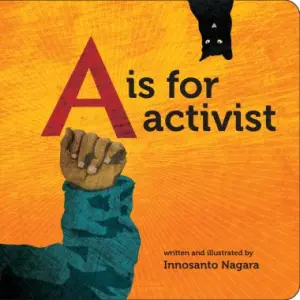
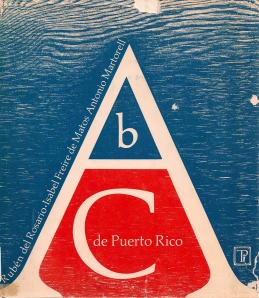
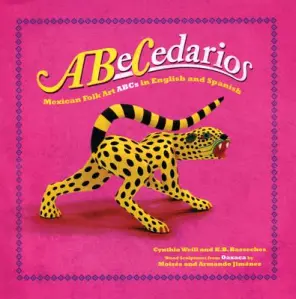
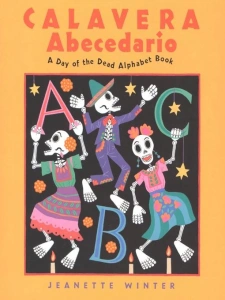
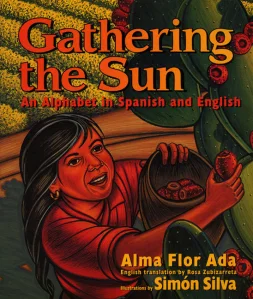
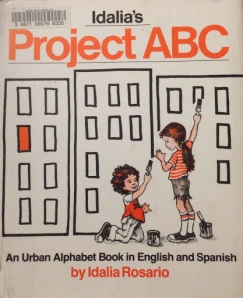
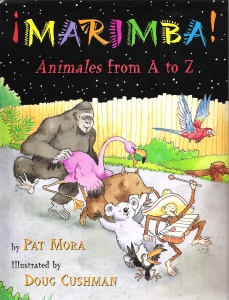
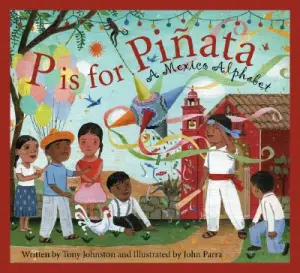

Thank you for sharing this wonderful collection! I will certainly share with everyone at my school, teachers, librarians, and the Spanish teacher. I have Alma Flor Ada’s book, which is great. I especially like the look of the 2 neighborhood books, and Marimba!
Hi, Linda. Thanks to you for sharing this list with your school! Please let me know how they are incorporating these books into the classroom. Yes, the neighborhood books are great and Marimba is a good book to intersect Spanish with Music/Art classes.
This is fantastic! I’m going to put these on our request list. Liam Miguel still enjoys alphabet books–great for emergent readers to have something to “read” on every page.
Hi, Ashley! Hope Liam Miguel enjoy these alphabet books! What I like about many of these books is that they incorporate a story or substance and move beyond “traditional” ABCs books. Let me know which one Liam likes the best. 🙂
Hi Sujei! I’m so glad to see RAD AMERICAN WOMEN A-Z included in this great list! I’d love to have my publisher send you an advance copy. Please let me know the best address for it to be sent to. And yes, D is for DOLORES HUERTA! And J is for JOVITA IDAR and S is for SONIA SOTOMAYOR!
Hi Kate! That would be great! I just followed you on Twitter and I can DM you my address. Thanks so much and looking forward to your book. 🙂
Pingback: Book Review: Evangelina Takes Flight | Latinxs in Kid Lit
I’m curious about the primary illustration. Is it found in one of the recommended titles? Thank you for the list!!
Hi! Yes, it’s from ABC de Puerto Rico (listed here!). -Sujei